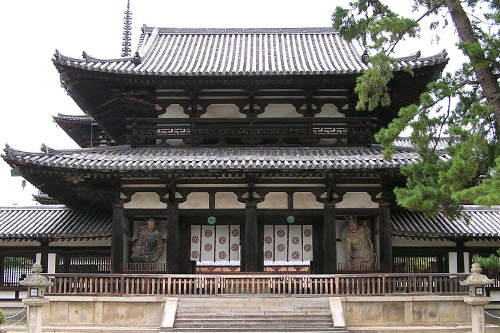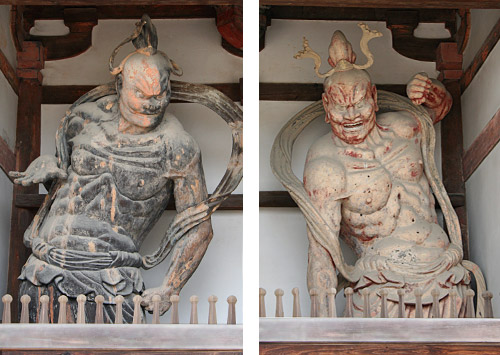|
||
 |
||


Houryuuji Chuumon 法隆寺中門 (Nara)
(C)2001 Japanese Architecture and Art Net Users System. No reproduction or republication without written permission.
掲載のテキスト・写真・イラストなど、全てのコンテンツの無断複製・転載を禁じます。
|
||||||
| Kongou rikishi 金剛力士 | ||||||
| KEY WORD : art history / iconography | ||||||
| Also *Niou 仁王, *Shukongoushin 執金剛神. Most commonly, these are the two threatening figures placed in the outer gates of a temple, one of which *agyou 阿形 has his mouth open, while the other, ungyou 吽形, is shown with his mouth closed. Since the Sanskrit name Vajradhara was translated into Chinese in a number of different ways, including Shukongoushin, Niou and Kongou rikishi, scholars consider them the same deity; however, the names Kongou rikishi or Niou refer to public figures used as gate guardians from the Nara period to the present. They are muscular, threatening and usually dressed in an Indian style with their torsos bare. Shukongoushin is a rare, esoteric deity, shown in armour, who appears as a single-pointed vajra. Examples of a figure holding a vajra and protecting the Buddha appear in India and in China; in Japan, the oldest examples of the Kongou rikishi are on the right and left corners of the Hakuhou period copper panel of Hasedera 長谷寺; while the oldest examples of sculptures in gates are those of the Houryuuji *Chuumon 法隆寺中門, which date from 711. Famous examples of the Kongou rikishi include the Nara period set in the Toudaiji *Hokkedou 東大寺法華堂 (Sangatsudou 三月堂, in armour), the Toudaiji *Nandaimon 東大寺南大門 set of 1203. The Nara period sculpture of Shukongoushin in the Toudaiji Hokkedou is a particularly famous sculpture, to which legend attaches magical powers. | ||||||
  Houryuuji Chuumon 法隆寺中門 (Nara)
|
||||||
| REFERENCES: | ||||||
| *a un 阿吽 | ||||||
| EXTERNAL LINKS: | ||||||
| NOTES: | ||||||
(C)2001 Japanese Architecture and Art Net Users System. No reproduction or republication without written permission. 掲載のテキスト・写真・イラストなど、全てのコンテンツの無断複製・転載を禁じます。 |
||||||